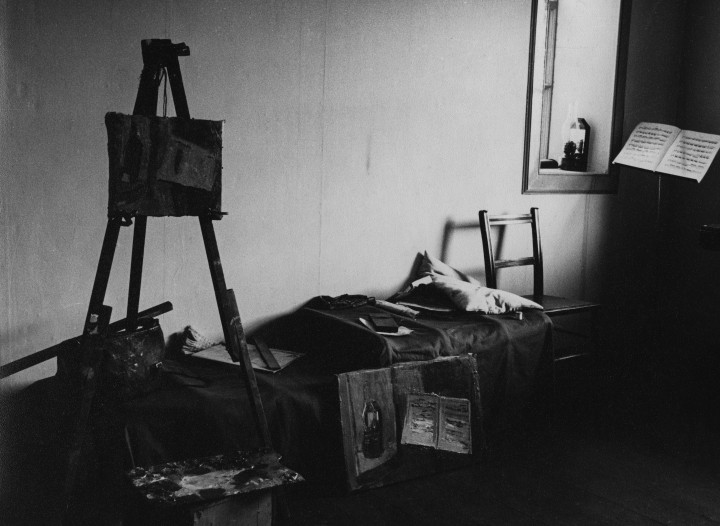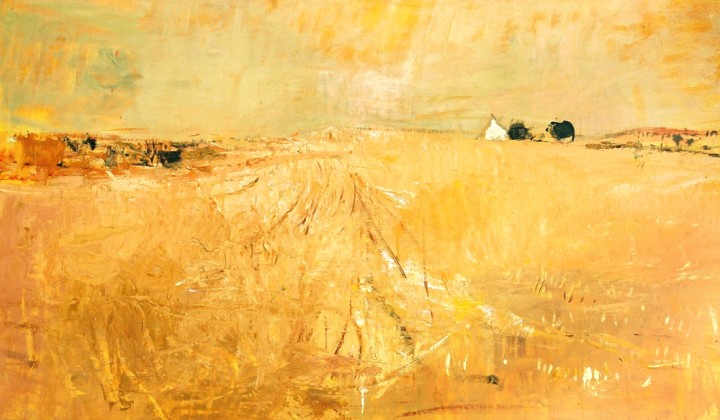Scottish Art News
Latest news
Magazine
News & Press
Publications
Joan Eardley in the Scottish Borders
By Susan Mansfield, 04.08.2023

The name Joan Eardley is intrinsically linked with two places: Townhead in Glasgow and the fishing village of Catterline, south of Stonehaven. Eardley, who is now regarded as one of the most important Scottish painters of the 20th century, is also celebrated for two distinct bodies of work: landscapes and seascapes around Catterline, and portraits of the street kids from Glasgow’s East End. She worked between the two places throughout her life.
However, an exhibition at Kirkcudbright Galleries this summer highlights the importance of a third place, a farm in Ettrickdale in the Borders where Eardley spent holidays with her friend Audrey Walker and her family. Eardley Explored: The Art of Joan Eardley with photography by Audrey Walker includes an important painting from this time, ‘The Clipping’, inspired by the sheep farms of Ettrickdale.
The painting, which is on long-term loan from the Walker family, shows Eardley engaging with a subject quite different from those for which she is best known. While she painted children in Townhead, her Catterline landscapes rarely include people. However, in Ettrickdale, she painted agricultural workers engaged in sheep shearing. The exhibition also includes a number of the drawings and watercolour sketches she made before creating the finished work.
Dawn Henderby, arts officer with Dumfries & Galloway Council, who put the exhibition together, says: ‘Audrey and her husband had a holiday home in the middle of nowhere,
an old farm cottage in Ettrickshaws, and Eardley would go and stay with them there. It was a very different landscape from Catterline, very green and focused on sheep farming. John Walker [Audrey’s son] remembered she [Eardley] always had
a pencil in her hand.
‘You can see how important drawing was to her for gathering information, and she didn’t do it by halves. Every day she was putting an image on the page, recording what she saw. You can see the work forming, from the sketchbook right up to the finished painting.’
 Joan Eardley, The Stubble Field, 1959. Courtesy of Dumfries and Galloway Council. © The Eardley Estate
Joan Eardley, The Stubble Field, 1959. Courtesy of Dumfries and Galloway Council. © The Eardley Estate
Walker, who was a talented photographer, took a great many pictures of Eardley (a significant number of which are in the Dumfries & Galloway collection). Today they offer a unique, intimate insight into her as a woman and as an artist. While Eardley was photographed by others, including Oscar Marzaroli, Walker’s images have the candour and ease of friendship.
‘The best of them really highlight her skill as a photographer,’ says Henderby. ‘They are interesting because she was documenting her friend, but she was good, she had a really good eye.’
Audrey Walker grew up in Doncaster, the child of a doctor, and was on course to become a professional musician. But when tennis elbow forced her to stop playing the violin she turned to photography as an outlet for her creativity.
She married Allan Grierson Walker, a lawyer who went on to become Sheriff Principal of Lanarkshire (making her Lady Walker) but was always drawn to the creative aspects of life.
Her daughter-in-law, Jane Walker, reflects: ‘She knew a lot about art and photography, had a lot of arty friends. The law and art didn’t really go together. Allan used to have to
go to special dinners and she would have to go along, get all dressed up, but she would long to get back home and get into something comfortable.’
Jane believes Audrey met Joan Eardley in 1952 through the artist Margot Sandeman, a friend of Eardley’s with whom she had studied at Glasgow School of Art. They may have bonded over music, which Eardley also loved. They remained close until Eardley’s early death from cancer in 1963 at the age of just 42. Audrey, along with Eardley’s mother and sister, was at her side when she died.
 Audrey Walker, Joan Eardley’s Studio in Townhead. Courtesy of the Artist’s Estate.
Audrey Walker, Joan Eardley’s Studio in Townhead. Courtesy of the Artist’s Estate.
Walker took pictures of Eardley at Catterline, painting on the beach in the teeth of the storm with her canvas weighted down with rocks, and in her studio in Glasgow where she painted local children. The Samsons, a family of 12 who lived near her in Townhead, were popular models.
Eardley, who used a camera herself to record details of the neighbourhood, asked Walker to photograph boarded-up shops and graffiti which she would use in the backgrounds of her paintings. Walker also photographed children playing in the streets and leaning from windows which became source material for Eardley’s work.
It was a photograph by Walker of Eardley’s Townhead studio that first inspired Henderby to create the current exhibition. ‘The photo shows Joan working in her studio in Townhead, and the painting which is in our collection, “Little Girl with a Squint”, is on an easel in the background,’ explains Henderby. ‘It made me realise how powerful it is to show the paintings and photographs together.’
The little girl in the picture, Ann Samson, and her sister Pat, who was also painted by Eardley, were the subject of
The Girls in the Picture, a recent radio documentary for BBC Scotland by journalist Audrey Gillan, in which they spoke candidly about their childhood in Townhead.
Audrey Walker, who died in 1996, carried on taking photographs in Glasgow after Eardley’s death. ‘She continued
to wander round the streets of Glasgow,’ says Jane Walker. ‘Some of her work looks a bit like the work of Oscar Marzaroli; she photographed children playing in gutters and on pavements, playing at schools in derelict houses. She particularly liked rooftops.’
In a moving tribute written by Audrey, which she asked not to be made public until after her death, she wrote: ‘To me, she [Eardley] was quite simply the winter sea, to which and for which I would give my life.’
.jpg) Joan Eardley, The Clipping Sketch, 1955. Courtesy of Dumfries and Galloway Council. © The Eardley Estate
Joan Eardley, The Clipping Sketch, 1955. Courtesy of Dumfries and Galloway Council. © The Eardley Estate
Eardley Explored: The Art of Joan Eardley with photography by Audrey Walker is exhibited at Kirkcudbright Galleries until 1st October




